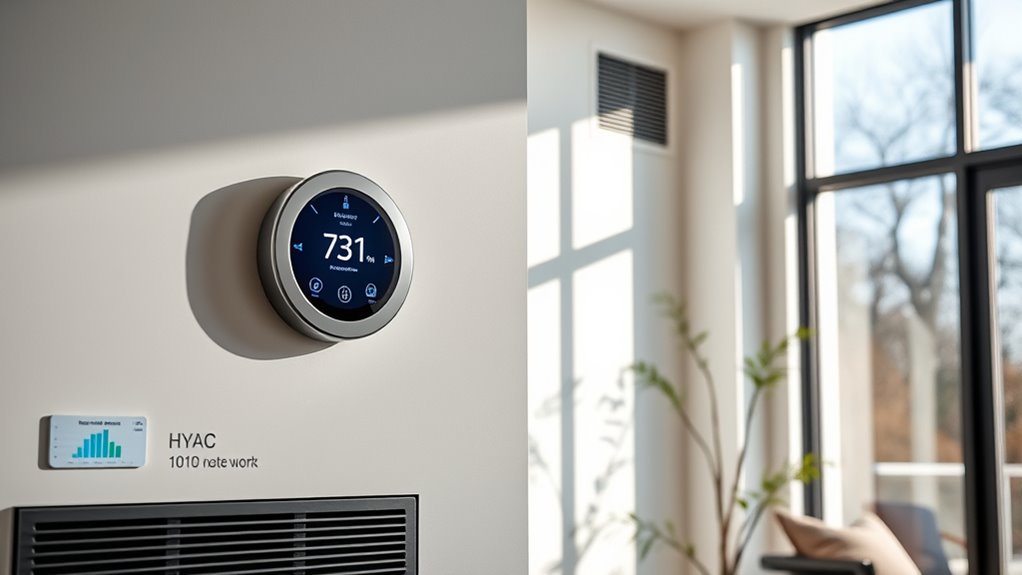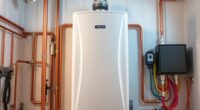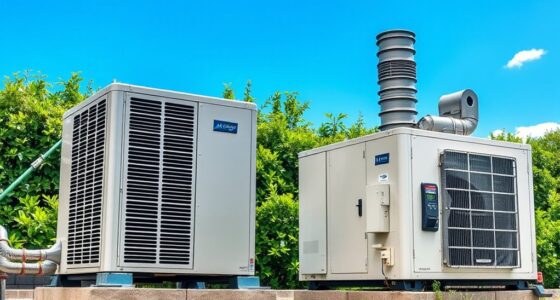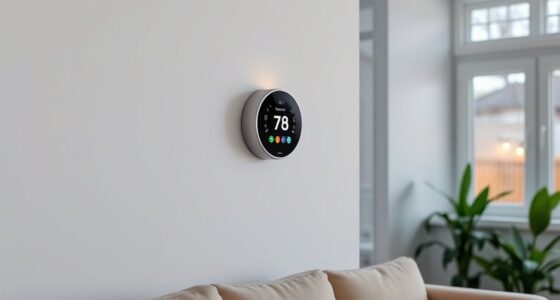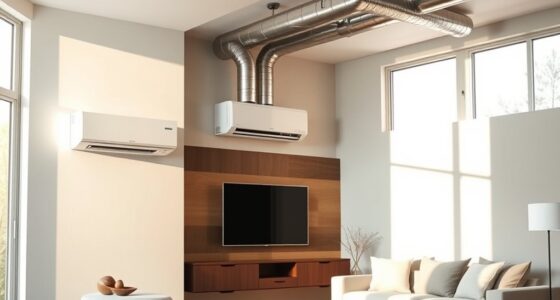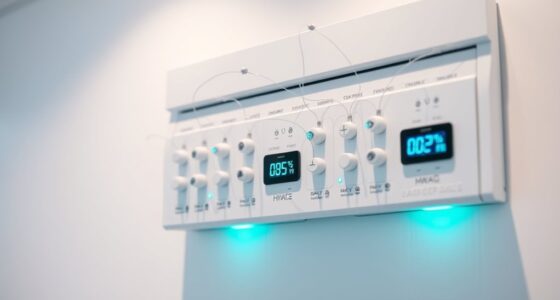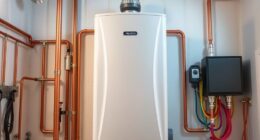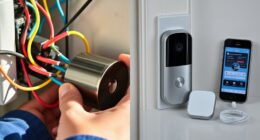Using smart HVAC systems helps you avoid peak energy rates by automatically adjusting heating and cooling during off-peak times, saving you money. These systems respond to real-time energy demand and fluctuation patterns, enabling you to pre-cool or pre-heat when rates are lower. They also coordinate with other smart devices for ideal use. If you want to discover how to maximize these savings and better manage your energy, there’s more to explore.
Key Takeaways
- Schedule heating and cooling during off-peak hours using automation and data-driven insights.
- Program pre-cooling or pre-heating to reduce energy use during peak demand periods.
- Automatically delay or adjust HVAC operation during high energy price times to minimize costs.
- Integrate HVAC with smart home systems to optimize overall energy consumption and cost savings.
- Monitor real-time energy demand patterns to proactively shift usage away from peak rates.

With energy prices often spiking during peak hours, smart HVAC systems offer an effective way to reduce your costs. These systems are designed to monitor and respond to fluctuations in energy demand, allowing you to avoid the most expensive periods of the day. By intelligently managing your heating, ventilation, and air conditioning, you can stay comfortable while minimizing your electricity bills. The key lies in tariff optimization—using data and automation to align your energy consumption with times when rates are lower.
Smart HVAC systems reduce costs by optimizing energy use during peak hours through data-driven tariff management.
When you install a smart HVAC system, you gain the ability to analyze real-time energy demand patterns. During peak hours, when the grid experiences high demand, electricity prices tend to skyrocket. Your system can automatically adjust or delay certain functions, like cooling or heating, to off-peak times. This not only saves money but also helps reduce strain on the overall energy grid. You don’t have to constantly monitor or manually turn off devices—your system does the work for you, optimizing usage based on current tariffs and demand levels.
Tariff optimization is critical for maximizing savings. Many utility providers offer variable pricing plans that fluctuate throughout the day, encouraging consumers to shift their consumption to cheaper periods. Your smart HVAC system can be programmed or learn to operate during these off-peak windows, ensuring your indoor environment remains comfortable without incurring unnecessary costs. For example, it might pre-cool your home early in the morning when rates are low, then maintain temperature during peak hours without active cooling. This proactive approach helps you take advantage of lower tariffs, making your energy usage more economical and sustainable.
Additionally, your smart system can integrate with other home automation devices to further enhance tariff optimization. For instance, it can coordinate with smart thermostats, solar panels, or energy storage units, creating a comprehensive energy management strategy. This integration ensures your entire household’s energy demand aligns with grid conditions, reducing overall costs and environmental impact. You might even receive alerts or insights into your energy consumption patterns, empowering you to make smarter choices and further avoid peak rates.
In essence, a smart HVAC system acts as your personal energy manager. By continuously monitoring energy demand and adjusting operations for tariff optimization, it ensures you spend less during costly peak periods. This not only benefits your wallet but also contributes to a more balanced and resilient energy grid. As energy prices become increasingly variable, leveraging smart technology for HVAC management becomes a wise and practical investment that keeps your comfort intact while saving you money.
Furthermore, understanding peak energy demand patterns can help you better plan your usage and maximize savings.
Frequently Asked Questions
Can Smart HVAC Systems Reduce Overall Energy Consumption Beyond Peak Rates?
Yes, smart HVAC systems can reduce overall energy consumption beyond just avoiding peak rates. They optimize your home’s energy efficiency by adjusting temperatures based on your habits and weather conditions, which leads to significant cost savings. By intelligently managing heating and cooling, you not only cut your energy bills but also extend your system’s lifespan. This proactive approach guarantees you’re using energy more efficiently, benefiting both your wallet and the environment.
What Are the Initial Costs Involved in Installing Smart HVAC Technology?
Think of installing smart HVAC technology as planting a seed for future savings. Your upfront investment covers installation costs, which vary based on system complexity and home size. Expect to spend between $2,000 and $5,000, including equipment and professional setup. While these initial costs seem high, they lead to reduced energy bills and better climate control, making your investment worth every penny in the long run.
How Secure Are Smart HVAC Systems Against Cyber Threats?
Smart HVAC systems are generally secure, but cybersecurity risks exist. You should guarantee your system has robust encryption and regular software updates to protect against hacking attempts. Be aware of data privacy concerns, as personal usage data might be collected. By choosing reputable brands and following best security practices, you can minimize these risks and enjoy the energy-saving benefits without compromising your home’s safety.
Do Smart HVAC Systems Require Professional Setup or Maintenance?
Did you know that over 60% of smart HVAC system users find professional installation essential? You’ll likely need professional installation to guarantee your system functions at its best. Ongoing maintenance is also important to keep the system running efficiently and to prevent issues. While some tasks are user-friendly, expert setup and regular professional maintenance help maximize your smart HVAC system’s savings and performance, making your home more comfortable and energy-efficient.
Can Smart HVAC Systems Integrate With Other Home Automation Devices?
Yes, smart HVAC systems can integrate with other home automation devices. You’ll find they support various home integration platforms, making it easy to sync with smart thermostats, lighting, and security systems. To guarantee seamless operation, check device compatibility beforehand. Once integrated, you gain centralized control, allowing you to optimize energy use and enhance home comfort effortlessly. This integration makes managing your smart home more intuitive and efficient.
Conclusion
By harnessing smart HVAC systems, you can steer clear of those costly peak energy rates like a skilled captain maneuvering through stormy seas. These systems act as your energy-savvy compass, adjusting temperatures when rates soar and saving you money while keeping your comfort intact. Embrace this technology, and you’ll steer your home’s energy use smoothly, avoiding financial turbulence. With smart HVAC, you’re not just saving energy—you’re charting a smarter, more efficient course for your home.
